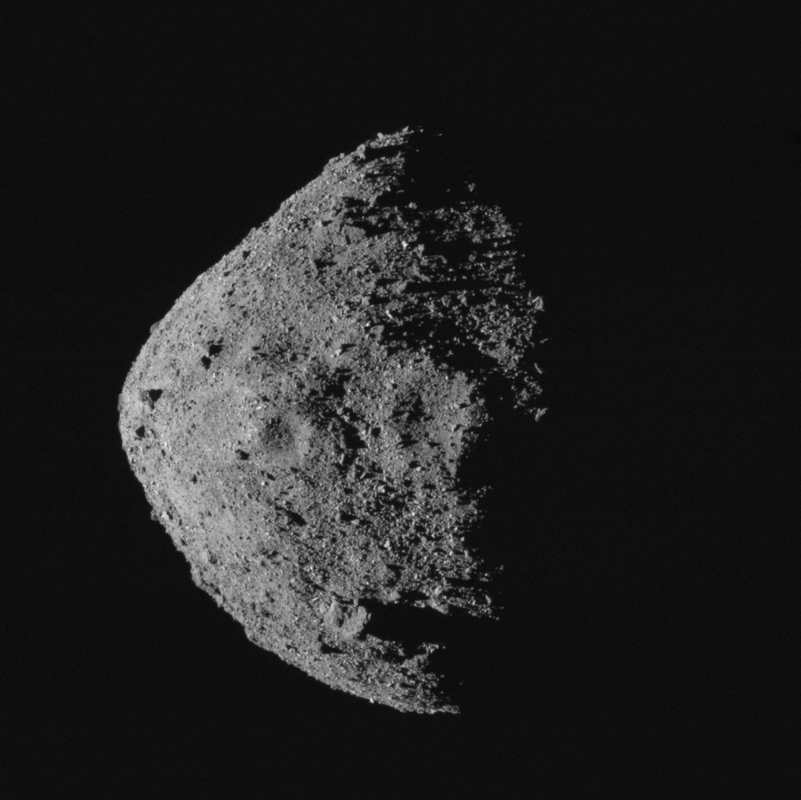|
By Charles Bonkowsky On October 20, NASA’s OSIRIS-REx probe will make its first attempt at retrieving pieces of an asteroid for study. The spacecraft will touch down over 200 million miles from Earth on the small, diamond-shaped asteroid named Bennu, landing for no more than a few seconds to collect loose particles of rock and dust from the surface before jetting away. If successful, it will become the first U.S. mission to retrieve samples from an asteroid and only the third in history, behind two Japanese probes, Hayabusa and Hayabusa 2. NASA is interested in bringing back these samples because asteroids are a type of “fossil record” from the early solar system. On Earth, we have no geologic record from the time of the planets’ formation due to tectonic activity and erosion. Asteroids and comets, in contrast, remain virtually unchanged. Retrieving samples will allow scientists to learn more about the solar system’s formation and evolution, as well as provide insight into the theory that organic compounds were brought to Earth by these rogue bodies of the solar system. The spacecraft was launched in late 2016 for its seven-year mission to return with samples from an asteroid, and has cruised for just over two years to Bennu. During that voyage, it scanned the area near Earth for any asteroids that could pose a threat to the planet as a test of its instruments and was even able to capture a few distant images of Jupiter. As it approached Bennu, OSIRIS-REx extensively imaged the asteroid in search of a landing site, creating detailed images such as the one below: In August of last year, NASA narrowed its options to four sample sites on Bennu: Nightingale, Osprey, Sandpiper, and Kingfisher. Nightingale was eventually selected as the optimal sample site due to its relative lack of hazards. Additionally, its crater is relatively young and well-preserved, allowing the spacecraft the opportunity to collect interior material from the asteroid. This material is likely to have avoided any small impacts or disturbances over the course of Bennu’s existence, and will offer a better early record of the solar system than if it were only surface material. Additionally, the OSIRIS-REx mission announced on October 8 that its sampling site held carbonaceous (carbon-containing) rocks and water-containing minerals—exactly the sort of compounds scientists were hoping to investigate. However, Nightingale still presents several challenges to the probe. The “safe area” of the sample site is about ten times smaller than was originally envisioned, and several boulders—including the building-size rock visible in the lower right side of the image above—could pose a hazard both on approach and exit. While the spacecraft is designed to autonomously back away if it detects a hazard, disturbing the sample site could mean that OSIRIS-REx will not be able to return safely. In the microgravity environment, the force of OSIRIS-REx’s thrusters could shift rocks into previously clear locations. Due to this danger, the mission team chose its backup location as site Osprey. What to Watch For NASA engineers and mission controllers have one central enemy: the speed of light. No signal can travel faster than light, so objects which are light-minutes or -hours away have a corresponding signal delay: the “transit time” for their signal to reach Earth, or for Earth’s signal to reach them. Just as the Curiosity Mars rover mission had its “7 minutes of terror”—when it attempted to perform a perfectly-controlled descent and landing while Earth was too far to receive a signal if something went wrong—OSIRIS-REx will have 18.5 minutes of delicate, unsupervised operations that must be performed autonomously. It will be 18.5 light-minutes away from Earth, unable to send or receive commands during the actual collection event; scientists on Earth will not know its outcome until it’s already over. But NASA scientists believe that they are prepared. In April and in August of 2020, OSIRIS-REx performed rehearsals of the sequence, dipping down to less than 100 meters from the surface before backing away. The rehearsals allowed the mission team to practice guiding the spacecraft in its four-hour descent to the “Checkpoint” altitude, where OSIRIS-REx checks its position, altitude, and velocity before autonomously firing its engines to reach the surface. All instruments were deployed correctly, and the obtained data showed that estimates of position and speed were correct. On October 20, the spacecraft will leave orbit and descend to the same checkpoint, 125 meters from the surface. During this time, it will deploy the TAGSAM (Touch-And-Go Sample Acquisition Mechanism) arm beneath it, whose collector is the only part which will actually touch down on the asteroid. After verifying the craft’s location, OSIRIS-REx will fire its thrusters again, stopping eleven minutes later at the “Matchpoint,” 54 meters above the surface, where it matches its speed to the asteroid’s location.
Assuming it detects no hazards on approach, it will then proceed to the surface, although OSIRIS-REx will only “land” for less than sixteen seconds. A pressurized nitrogen bottle will fire into the loose regolith at the surface, blowing some of the surface material into the collector of the TAGSAM before the spacecraft backs away into a space orbit. Brief uploads of telemetry will be sent back during the approach and landing, allowing the mission team to confirm whether or not OSIRIS-REx made a successful landing. What’s Next If the spacecraft successfully lands, OSIRIS-REx will send back images of material within the TAGSAM collector to allow the mission team to verify that a sample was collected. If the spacecraft collects a sufficient amount of rocky material, the sample will be placed in the Sample Return Capsule (SRC) for expected return to Earth. However, if the spacecraft detects hazards on landing and has to back away beforehand or fails to collect sufficient sample material, there are still extra chances. OSIRIS-REx carries three pressurized nitrogen bottles, meaning that up to three attempts at collection can be made, though it will take more time due to safety concerns about the selected sites. It will have to re-image the Nightingale site to check for disturbances, so that the mission team can decide whether to attempt another landing at Nightingale or to move to the backup site at Osprey—whichever they choose, a second attempt can be made no earlier than January of next year. The key part of the OSIRIS-REx mission, though, is the sample return. The spacecraft is charged with collecting around 60 grams of material from Bennu, the largest extraterrestrial sample returned since the Apollo missions, and it has to return safely. In March 2021, assuming sample collection is successful,, OSIRIS-REx will depart Bennu and begin its trajectory to pass by Earth in September 2023. As it flies by, it will eject the SRC into the atmosphere at over 20,000 miles per hour—the SRC, as it enters the atmosphere, will be the second-fastest object ever to return to Earth, behind the Stardust comet-return capsule. After slowing down in the atmosphere, the capsule will eventually land in Utah to be recovered and analyzed. Images are sourced from nasa.gov and are public domain. Credit: NASA/Goddard/University of Arizona.
0 Comments
Leave a Reply. |
Categories
All
Archives
April 2024
|





